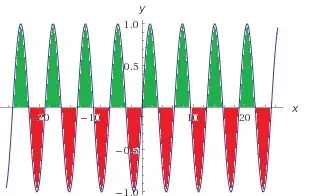As has already been noted, this is an improper integral and has to be defined in the limit. To look at one half of this integral, we can take the limit of the integral from a fixed point to some other point as that goes to infinity: $$ \lim_{a \to \infty} \int_{x_0}^a {sin(x)}dx$$ for any $x_0$, not necessarily 0.
But this does not converge; we define convergence to be only if the sequence gets arbitrarily close to the point to which it converges. The idea is that, the farther you look, the closer you'll get, no matter what value you choose. So, if you pick some point of the sequence out yonder, and it is yea distance from the limiting point, you shouldn't be able to find some other point out further in the sequence, and have it be farther away from the limiting point, because you were already that close to the limiting point.
But this limit doesn't do that. It gets arbitrarily close to zero, even coinciding, and then gets farther away again. It goes up and down and never "settles in" to any fixed point. So this integral does not converge.
As has again been noted, if we were to look at the integral symmetrically, i.e., define it as $$\lim_{a\to\infty} \int_{-a}^a sin(x) dx$$
then they would cancel out at every point and would be zero no matter where you looked, so this would converge. Again, however, this would violate another rule that we like to demand of improper integrals, namely, that you can split them down the middle, i.e. $$\int_{-\infty}^\infty sin(x)dx = \int_{-\infty}^{x_0} sin(x)dx + \int_{x_0}^\infty sin(x)dx$$
for any point $x_0$, after these integrals have been suitably defined. So, if any one of these integrals is not defined, then neither should the original one be.
So I hope that intuitively explains it for you.
